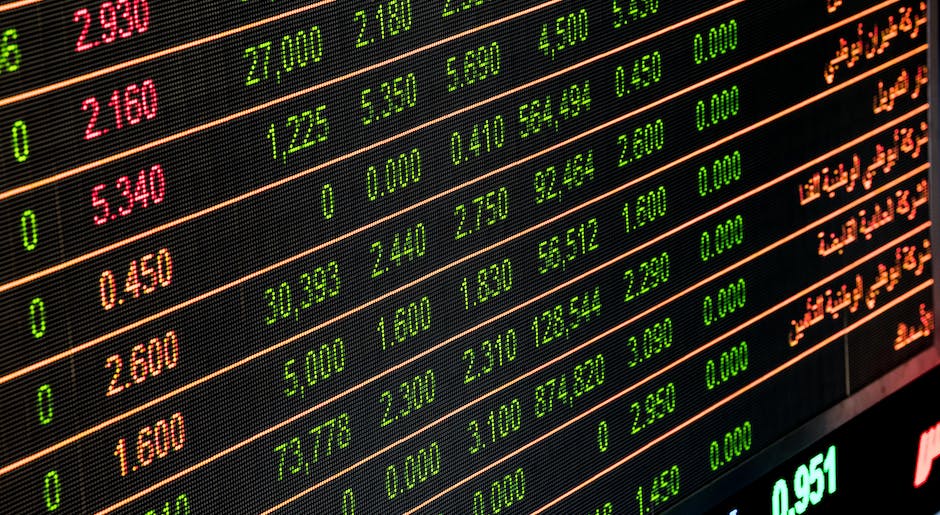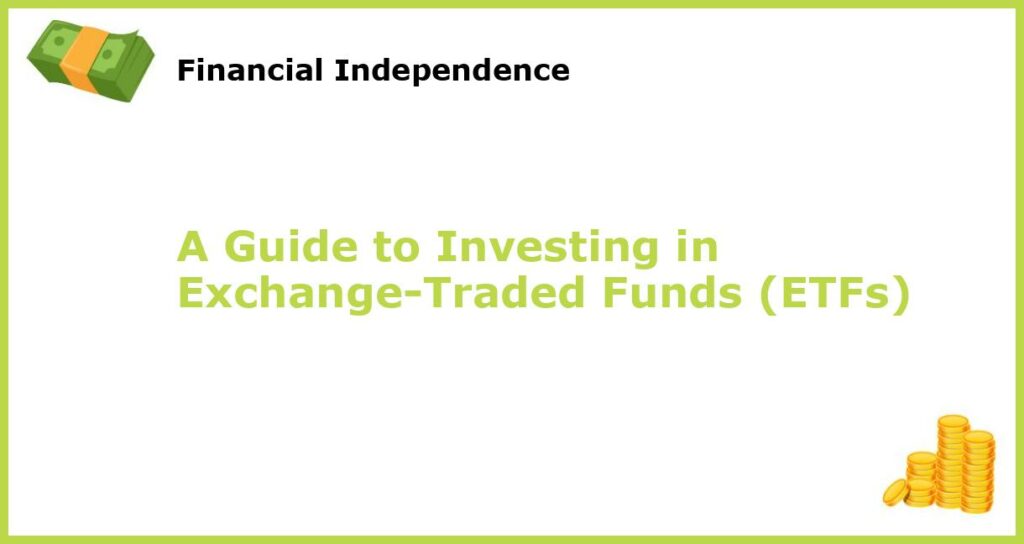Investing can be a daunting task, especially if you’re not well-versed in the world of finance, but with the right knowledge, you can make informed decisions and achieve your financial goals. One of the investment options is exchange-traded funds (ETFs), which have become increasingly popular among both novice and experienced investors. This guide will provide an overview of ETFs, their advantages and drawbacks, and how you can make the most of them in your investment portfolio.
What are ETFs?

ETFs are open-end investment funds that consist of a collection of assets, such as stocks, bonds, and commodities, and trade on stock exchanges like an individual stock. Its value fluctuates throughout the day depending on the trading activity on the market. ETFs are similar to mutual funds, but they trade like a stock, and the management fees are typically lower.
ETFs can hold a mix of securities, including stocks, bonds, and other investments. The mix can be broad or narrow, depending on the ETF’s investment objective. They can be passive, which means they track an underlying index, or active, which means a manager chooses the investments.
ETFs are advantageous for investors looking to gain exposure to many securities in one trade. They also offer the advantage of flexibility since they can be bought and sold throughout the trading day, enabling investors to get in and out of positions easily.
How do ETFs work?

ETFs function similarly to traditional mutual funds in that they hold a group of securities in their portfolios. The primary distinction between the two types of funds is how they trade. Mutual funds are bought and sold at their daily net asset value (NAV), which is determined at the market’s close. ETFs are bought and sold throughout the day at market prices, which may differ from their NAV.
ETFs typically track specific indexes, sectors, or other baskets of securities to mirror the prices of those baskets. Some ETFs could also track commodities like gold or oil.
What are the benefits of investing in ETFs?

ETFs hold several advantages over other types of investments, such as their flexibility, cost-effectiveness, diversification potential, and tax efficiency. Below are some of the key benefits of investing in ETFs.
Diversification: ETFs enable investors to own a diversified portfolio of assets with just one purchase. When you buy an ETF, you get exposure to a basket of stocks, which spreads your risk. This is something investors might find challenging to do on their own.
Low-cost: ETFs operate with lower fees than many mutual funds, making them a relatively cost-efficient means of gaining exposure to multiple securities simultaneously.
Flexibility: ETFs are traded throughout the day, making them easier to buy and sell compared to traditional mutual funds, which are bought and sold at the end of the trading day at the net asset value (NAV) price.
Tax efficiency: ETFs can be more tax-efficient than mutual funds because of their structure. Unlike mutual funds, which must sell underlying securities to meet redemptions, they supply or redeem ETF shares directly to authorized participants (APs) instead of cash. This provides tax advantages to investors as ETFs can avoid incurring capital gains tax liabilities, which would cause taxes to increase
How do you buy and sell ETFs?

ETFs can be bought and sold like a stock on a stock exchange. An investor must open a brokerage account and purchase ETFs from the exchange. The underlying prices of ETFs vary throughout the day based on the performance of the basket of underlying assets. Investors entering orders to buy or sell ETF shares can do so during regular trading hours, typically from 9:30 a.m. to 4 p.m. eastern time.
What are the risks of investing in ETFs?
Investing in ETFs comes with its risks. For one, investing in ETFs with a narrow focus can result in high volatility and higher risk. For instance, some ETFs might be invested in a particular sector or theme, such as healthcare or tech companies, which could be affected by government regulations or business cycles.
Another factor to consider is their liquidity risk. Although ETFs are easy to trade, some ETFs have less trading volume than others, which could make it more challenging for investors to buy and sell them quickly.
How to choose the right ETFs to invest in?
Choosing the right ETFs requires some research and due diligence. Investors can minimize the risks of investing in ETFs by profiling their investment goals, risk tolerance, and time horizon before making their choice. Here are some of the factors you should consider:
Objective: The reason for investing in an ETF will shape which one is suitable for you. For example, an investor looking to get exposure to a particular sector, say real estate or technology, will find an ETF that invests in that sector.
Expense Ratio: The expense ratio shows how much investors will pay in fund management fees. Investors should look for lower expense ratios.
Liquidity: Investors should consider the trading volume of ETF shares. High-volume ETFs are more liquid than low-volume ETFs, meaning investors can buy or sell them more quickly.
Asset Class: Investors should choose ETFs aligned with their investment objectives, such as stocks or bonds, to build a balanced and diversified portfolio.
What are the tax implications of investing in ETFs?
ETFs are tax-efficient compared to mutual funds. This is because ETFs can make transactions without creating taxable capital gains. Instead, ETFs transfer shares in-kind, a process that does not generate a taxable event. When investors sell shares of ETFs for a profit, they are subject to a capital gains tax.
Short-term traders looking to make quick profits by buying or selling ETFs will need to account for their taxable capital gains or losses. Long-term investors, on the other hand, may reduce their tax liability by holding onto ETFs for extended periods of time.
How do ETFs compare to mutual funds?
ETFs are similar to mutual funds, but they have several advantages over them.
ETFs have lower fees than mutual funds. Mutual funds charge a range of fees, such as management fees, transaction fees, and redemption fees. ETFs, on the other hand, have a low expense ratio.
Secondly, mutual funds are slower to trade than ETFs. Mutual fund orders are executed at the end of each trading day, which can cause delays in buying and selling. ETFs, however, can be traded throughout the day alongside equities, allowing investors to capitalize on market events.
Thirdly, ETFs are available to trade on global exchanges. With the rise of the internet, investors can trade ETFs from different parts of the world. Mutual funds may not have that level of accessibility.
How to use ETFs in your investment portfolio?
ETFs can be used in various ways to improve the risk-return profile of a portfolio. Since ETFs invest in multiple securities, they provide diversification benefits. Below are some strategies investors can use:
Asset Allocation: ETFs offer an excellent way to allocate funds across different investment classes, such as equities, commodities, and bonds, based on an investor’s long-term goals and risk tolerance.
Core and Satellite strategy: This strategy involves using ETFs as the core of an investment portfolio and complementing it with individual stocks or bonds for the satellite positions.
Tactical asset allocation: ETFs can be used to make short-term market bets on specific sectors or themes. This strategy involves identifying market trends and then investing in ETFs that reflect that trend.
What are some popular ETFs to consider?
As with any investment, ETFs come in a variety of shapes and sizes. Investors should take the time to research and analyze individual ETFs to determine which would best fit their investment profiles. Here are some of the most popular ETFs:
SPDR S&P 500 ETF: This ETF invests in 500 of the largest US market-capitalization companies.
Invesco QQQ Trust: This ETF tracks the Nasdaq-100 Index and invests in the largest nonfinancial US and international stocks.
Vanguard Total Stock Market ETF: This ETF is constructed to provide investors exposure to the entire US equity market, including small-, mid-, and large-cap stocks.
iShares MSCI EAFE ETF: This ETF tracks the MSCI EAFE Index, which is composed of developed market stocks from Europe, Asia, and Australia.
Investors can seek advice from a financial advisor to determine the ETFs that align with their goals and risk tolerance.







